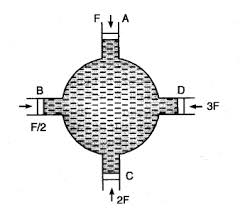Answer
436.2k+ views
Hint: We know that, if we apply pressure at one side, then to the remaining portion pressure is transmitted in the same amount and pressure is inversely proportional to area.
Complete step by step answer:
In this question the assertion is correct. Pascal’s law is the working principle of hydraulic lift. But whatever reason is given for this is not correct. Because, according to Pascal’ law it tells us that if an external pressure is applied then it is transmitted to every portion of the fluid and the wall of the containing vessel by the same amount.
Pascal’ law can be experimentally proved as follows: consider a vessel with a number of opening of different cross-sectional areas \[{A_1},{A_2},{A_3}\] and A4, all of which are fitted with water tight movable pistons a, B, C, and D respectively. Let the vessel be completely filled with water and the pistons be kept in position. If any of the pistons, say A, is now pressed inwards, all the other pistons will be found to move outward. This indicates that the external pressure is transmitted in all directions. If the force applied on the piston A is F1, the pressure exerted on the liquid is $\dfrac{{{F_1}}}{{{A_1}}}$ . in order to prevent the motion of other piston additional forces F2, F3 andF4 have to applied on B,C and D respectively.

It is found that
$\dfrac{{{F_1}}}{{{A_1}}} = \dfrac{{{F_2}}}{{{A_2}}} = \dfrac{{{F_3}}}{{{A_3}}} = \dfrac{{{F_4}}}{{{A_4}}}$ .
From this small observation, we can say that if we apply pressure at one side of the closed container, then this pressure is equally transmitted to every portion of the container.
Similarly, we can explain how this hydraulic lift is working by using Pascal’s law.
A hydraulic lift is based on Pascal’s law and it is used to either support or lift heavy objects. It consists of two cylinders and applies force per unit area, that is the pressure at one end then pressure is transmitted to the other end also. That is if we apply a small force at the input port of the cylinder then the output part force will be more depending on the area of a cross-section of the cylinder. But pressure developed at both sides is the same. That is why heavy loads such as cars and trucks can be lifted by the application of small force.
Note:
Pressure is normal force per unit area.
It is a scalar quantity because it has only magnitude.
SI unit of pressure is Pa (pascal).
Complete step by step answer:
In this question the assertion is correct. Pascal’s law is the working principle of hydraulic lift. But whatever reason is given for this is not correct. Because, according to Pascal’ law it tells us that if an external pressure is applied then it is transmitted to every portion of the fluid and the wall of the containing vessel by the same amount.
Pascal’ law can be experimentally proved as follows: consider a vessel with a number of opening of different cross-sectional areas \[{A_1},{A_2},{A_3}\] and A4, all of which are fitted with water tight movable pistons a, B, C, and D respectively. Let the vessel be completely filled with water and the pistons be kept in position. If any of the pistons, say A, is now pressed inwards, all the other pistons will be found to move outward. This indicates that the external pressure is transmitted in all directions. If the force applied on the piston A is F1, the pressure exerted on the liquid is $\dfrac{{{F_1}}}{{{A_1}}}$ . in order to prevent the motion of other piston additional forces F2, F3 andF4 have to applied on B,C and D respectively.

It is found that
$\dfrac{{{F_1}}}{{{A_1}}} = \dfrac{{{F_2}}}{{{A_2}}} = \dfrac{{{F_3}}}{{{A_3}}} = \dfrac{{{F_4}}}{{{A_4}}}$ .
From this small observation, we can say that if we apply pressure at one side of the closed container, then this pressure is equally transmitted to every portion of the container.
Similarly, we can explain how this hydraulic lift is working by using Pascal’s law.
A hydraulic lift is based on Pascal’s law and it is used to either support or lift heavy objects. It consists of two cylinders and applies force per unit area, that is the pressure at one end then pressure is transmitted to the other end also. That is if we apply a small force at the input port of the cylinder then the output part force will be more depending on the area of a cross-section of the cylinder. But pressure developed at both sides is the same. That is why heavy loads such as cars and trucks can be lifted by the application of small force.
Note:
Pressure is normal force per unit area.
It is a scalar quantity because it has only magnitude.
SI unit of pressure is Pa (pascal).
Recently Updated Pages
When people say No pun intended what does that mea class 8 english CBSE

Name the states which share their boundary with Indias class 9 social science CBSE

Give an account of the Northern Plains of India class 9 social science CBSE

Change the following sentences into negative and interrogative class 10 english CBSE

Advantages and disadvantages of science

10 examples of friction in our daily life

Trending doubts
Difference between Prokaryotic cell and Eukaryotic class 11 biology CBSE

Which are the Top 10 Largest Countries of the World?

Fill the blanks with the suitable prepositions 1 The class 9 english CBSE

Differentiate between homogeneous and heterogeneous class 12 chemistry CBSE

Difference Between Plant Cell and Animal Cell

10 examples of evaporation in daily life with explanations

Give 10 examples for herbs , shrubs , climbers , creepers

Write a letter to the principal requesting him to grant class 10 english CBSE

How do you graph the function fx 4x class 9 maths CBSE



